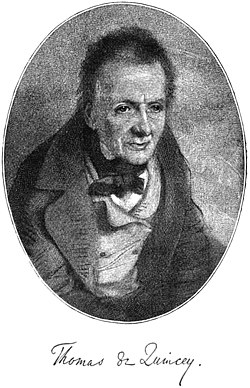Opium during the Romantic Era
Opium and the Orient
The fascination and experimentation with opium occurred partially because of its connections to the oriental tales such as Purchas his Pilgrimage, Travels through Persia, and Memoires du Baron de Tott, sur les Turcs et les Tartares ("Baron de Tott's memoires - on the Turks and the Tartars"), in which opium use was emphatically featured. [2] In the eighteenth century, opium was primarily imported to Britain from countries like Persia, Egypt, Smyrna, and the Levant areas. [3] Opium imports from Turkey dominated in Britain which accounted for 80-90% of the share brought in during the majority of the nineteenth century. [2] Although most of the opium came from the Orient, attempts were made to grow opium in England as an "agricultural improvement." [4]
For a while, opium was used as a currency for trading activities with China, because while other nations had to pay great amounts of silver for tea, British merchants used Indian opium and cotton as a bargaining chip for imports. [5] As importation increased, many patent opium products appeared and were sold in general stores as well as apothecaries. [6] These patent medicines included Godfrey's Cordial, Dalby's Carminative, McMunn's Elixir, Batley's Sedative Solution, and Mother Bailey's Quieting Syrup. [7] As opium functions as an appetite suppresant, children in Britain were sometimes given doses of the drug to quench their appetites. Contemporary observers noted that children who were regularly fed opium were often in very poor health, with a few adults even being charged with killing children through opium poisoning. [8]
Medical uses and effects

The Swiss alchemist and physician Paracelsus (1493-1541) is often credited as the first to create a tincture of opium. In the 17th century, the English physician Thomas Browne conducted experiments upon the dosage of opium on various animals. [9] Browne's contemporary, the physician Thomas Sydenham (1624–89) the so-called 'Father of British medicine' declared -
Among the remedies which has pleased the Almighty God to give to man to relieve his sufferings, none is so universal and so efficacious as opium . [10]
In the 1730s Dr. Charles Alston in one of his papers describes the biology or botany of the poppy plant, and the experiments he conducted with it on animals. One section of his paper describes how opium was believed to treat pain, cause sleep, increase perspiration, raise the spirits, and relax the muscles. With these things in mind, it was recommended for pain and any sort of irritation to the nerves or motions of spirits. [11] Opium became a popular "aspirin-like" product of the early nineteenth century. George Crabbe was prescribed opium in 1790 to relieve pain, and he continued to use it for the rest of his life. At the time of George Crabbe's first prescription, the East India Company began hiring Indian Villages to cultivate large quantities of opium. [12] Medicinally, it had been used as a reliable cure since the beginning of the medical field. [13] William Cullen and John Brown, two well-known physicians at the time, claimed it cured things such as typhus, cancer, cholera, rheumatism, smallpox, malaria, venereal disease, hysteria, and gout in the eighteenth century. [14] However, some individuals recognized the dangers that opium held. Some wrote into newspapers, such as The Times , and emphasized the dangers of giving a child medication such as the "Syrup of Poppies" or other potent medications, which contained an unspecified amount of opium known to be dangerous to give to infants. [15] A deeper medical analysis revealed that opium created and uplifted spirit and happy disposition, which was then followed by symptoms of a very opposite effect which includes the mind "becoming gradually dull and languid, the body averse to motion, little affected by customary impressions, and inclined to sleep". Following a larger dose, "all these symptoms continue to increase; and tremors, convulsions, vertigo, stupor, insensibility, and deprivation of muscular action appear". [3] Regardless of the mixed reviews in the public sphere, during the time of increasing imports and the unconcern of doctors (especially demonstrated by certain journals documenting how to cultivate the poppy plant and create opium), [16] there were more hard drugs in England than any time before or any time that followed. [17] Eventually, the drug moved beyond medicinal use as its imaginative powers attracted attention—the descriptions accompanying the effects of opium moved from drowsy effects to those of its power over the imagination and thought process. [18] This was especially true within the circle of Romantic poets, specifically Samuel Taylor Coleridge and Thomas De Quincey, who suffered from addiction to opium.
